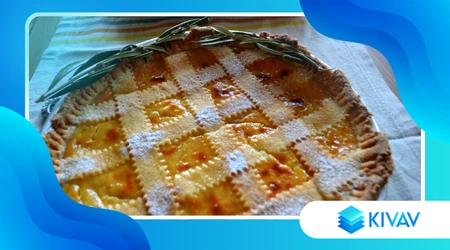Neapolitan Pastiera: Easter Cake

There Neapolitan Pastiera: Easter cake is much more than just a dessert: it's a sensory experience, a journey through history, and a tribute to Neapolitan culture.
Announcements
Every year, around Easter, homes fill with the unmistakable scent of orange blossoms, ricotta, and cooked wheat.
But what makes this dessert so special? Why has it endured for centuries, despite the evolution of modern pastry making?
The answer lies in its authenticity, in its ability to unite the sacred and the profane, tradition and innovation.
In this article, we will explore the origins, ingredients, techniques and secrets of the Neapolitan Pastiera, with real data, concrete examples and curiosities that few know.
Announcements
1. The origins: between legend and documented history
There Neapolitan Pastiera It has its roots in a mix of mythology and history.
It is said that the siren Partenope, symbol of Naples, emerged from the sea every spring to delight the inhabitants with her song.
One year, to thank her, the Neapolitans offered her seven gifts from the earth: ricotta, wheat, eggs, spices, sugar, orange blossom water, and shortcrust pastry.
From this union was born the Neapolitan Pastiera: Easter Cake, a tribute to the rebirth of nature.
Historically, however, the recipe was perfected by the nuns of the monastery of San Gregorio Armeno in the 16th century.
Here, the nuns added cooked wheat to milk, creating the creamy consistency we know today.
An example? Even today, some historic pastry shops in Naples, like Scaturchio, use secret recipes passed down through generations of nuns.
2. The ingredients: symbolism and quality
Each component of the Neapolitan Pastiera it has a profound meaning, linked to Easter and spring.
- Cooked wheat: represents fertility and rebirth, a reference to the Resurrection.
- Sheep's milk ricotta: symbol of purity, it must be very fresh to ensure creaminess.
- Candied fruit and orange blossoms: they evoke the awakening of nature after winter.
A common mistake? Using cow's milk ricotta instead of sheep's milk ricotta, resulting in a less flavorful dessert.
Practical example: Pasticceria Poppella, in Naples, selects only Agerola ricotta, known for its natural sweetness.
+Zabaglione: traditional Italian cream
And what about candied fruit? The traditional ones are citron and orange, but some also add a hint of pumpkin to balance the bitterness.
3. The authentic recipe: steps and secrets
Prepare a Neapolitan Pastiera perfect takes time and precision.
Phase 1: The wheat
It must be left to soak for 48 hours, then slowly cooked with milk and lemon peel.
Phase 2: The dough
The shortcrust pastry must be worked cold, with high-quality butter and a hint of vanilla.
Phase 3: Cooking
Bake at 160°C for 60 minutes, keeping an eye on it constantly to prevent cracking.
A grandmother's trick? Place a small bowl of water in the oven to maintain humidity.
Innovative example: Chef Ciro Salvo of Pizzeria 50 Kalò created a “deconstructed” version, serving the cream of wheat in a glass with shortcrust pastry crumble.
4. Statistics and curiosities

According to Coldiretti (2024), the 68% of the Neapolitans is still preparing the Neapolitan Pastiera at home, against the 42% of the rest of Italy.
Furthermore, in the last 5 years, online searches for “Pastiera recipe” have increased by 35%, a sign of renewed interest.
Interesting fact? In New York, the Villabate Alba pastry shop sells over 1,000 pastiere at Easter, demonstrating the global love for this dessert.
5. Regional and modern variants
While the classic version is immutable, some chefs experiment with respect.
- Chocolate Pastiera: addition of cocoa to the cream (e.g. Pasticceria Capparelli).
- Vegan Pastiera: without eggs and dairy products, but with almond cream (e.g. Dolcemente Green laboratory).
And while in Sicily there's a version with salted ricotta, in Rome some use honey instead of sugar.
6. Why does Pastiera last over time?
The answer is simple: it's memory.
Every forkful takes you back to childhood, to grandmothers mixing the wheat, to Sundays spent waiting.
In an age of industrial sweets, the Neapolitan Pastiera: Easter Cake It remains an act of cultural resistance.
7. The evolution of pastiera: from convents to large pastry shops
There Neapolitan Pastiera It began its journey in convents, but today it occupies a place of honor in the best pastry shops in the world.
Great chefs like Gino Sorbillo have taken this dessert to new heights, maintaining tradition but perfecting the techniques.
In Naples, historic restaurants like Pintauro and Leopoldo continue to use original recipes, while others like Dolce Idea are introducing gluten-free versions.
The democratization of gastronomy has allowed the Neapolitan Pastiera: Easter Cake to overcome boundaries, adapting without losing its essence.
8. The preparation ritual: an act of love and patience
Making a pastiera isn't simply following a recipe—it's a ritual that requires dedication. From selecting the ingredients to baking, every step has its own meaning.
Many Neapolitan families maintain the tradition of preparing the dessert on Holy Thursday, transforming the kitchen into a space for sharing and remembrance.
It is common for grandmothers and granddaughters to work together, ensuring that the recipe secrets are not lost over time.
Recommended reading: Coldiretti – Easter Traditions 2024
9. Pastiera in popular culture: cinema, music and literature
There Neapolitan Pastiera It's not just a dessert – it's a cultural icon. It appears in films like Vittorio De Sica's "The Gold of Naples" (1954) and even in traditional songs.
Writers such as Luciano De Crescenzo have mentioned it in their works, celebrating its role in Neapolitan identity.
Eduardo De Filippo's theatre also used it as a symbol of affection and family tradition.
10. Tips for recognizing an authentic pastiera
Not all pastieras sold as "traditional" follow the original criteria. A good one Neapolitan Pastiera must have:
- A golden and slightly crunchy crust
- A creamy but not liquid filling
- A strong aroma of orange blossom
It's best to avoid versions with a pudding-like consistency or too sugary – the balance of flavors is key.
A tip? Try the pastiera from Antica Pasticceria Carraturo, which has been using artisanal methods since 1837.
Conclusion: A dessert that unites generations
There Neapolitan Pastiera it's not just a dessert.
It is a symbol of identity, a rite that is renewed every Easter.
++Jam tart: simple and authentic
Whether it's the classic version or a reinterpretation, the important thing is to maintain its soul.
And you, do you prefer it traditional or with a modern twist?
Frequently Asked Questions (FAQ)
1. Can Pastiera be frozen?
Yes, but only after cooking. Defrost in the refrigerator for 12 hours before serving.
2. How long does it last?
Up to 5 days in the fridge, but is perfect within 48 hours.
3. Why does the surface break?
Too much heat in the oven. Use slow, controlled cooking.
